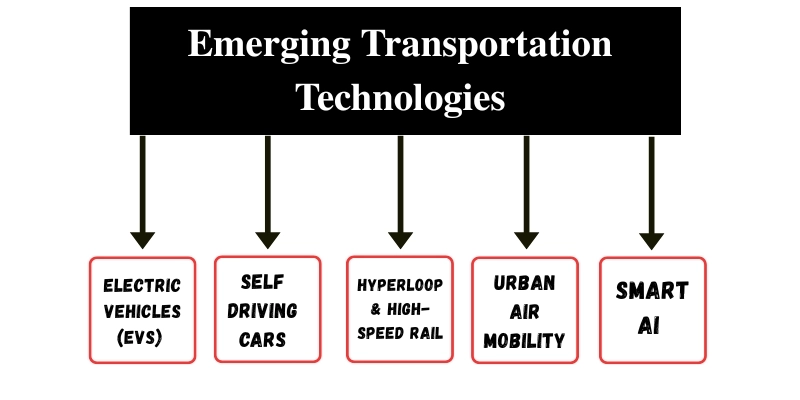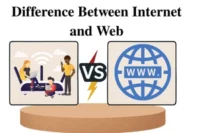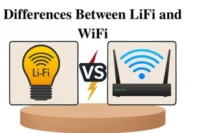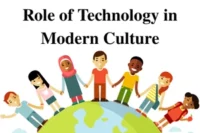5 New Transportation Technologies You Must Know in 2025 That Will Revolutionize Travel
Published: 15 Aug 2025
Did you know that how we travel today will completely change within the next decade? Imagine a world where self-driving vehicles are commonly used, flying taxis fly through the sky, and a Hyperloop train allows you to travel between cities in minutes. This is not simply a fantasy. New technology in transportation is becoming a reality day by day.
With rapidly advancing technology, we are on the edge of a transportation revolution. These innovations will revolutionize not only how we travel but also our cities and their surrounding environment.
This article examines some of the most remarkable emerging technologies in transportation. From electric vehicles to self-driving cars, flying taxis, and AI-powered traffic systems, these advancements promise to make travelling smarter, quicker and more efficient than ever.
Let’s dive into the future of transportation!

Top 5 Emerging Transportation Technologies
Here you’ll see the latest and most trending technologies of transportation.
1. Electric Vehicles (EVs) and Green Transportation
Electric vehicles (EVs) are cars that run entirely on electricity stored in batteries rather than gasoline or diesel engines. These vehicles rely on latest technologies in transportation to ensure better energy efficiency, faster charging and more sustainable options to traditional combustion-engine vehicles.
EVs are at the forefront of future technologies in transport, helping to reduce global carbon emissions and promote green energy.
Latest Trends and Data
According to the International Energy Agency (IEA), EV adoption is growing at an exponential rate worldwide, with over 10 million electric vehicles projected to be on the road by 2020. Projections suggest that by 2030, new transportation technology will make up nearly 40% of the global car market.
In Norway, over 50% of all new cars sold in 2020 were electric. Moreover, transportation technologies such as advanced battery systems are being developed to offer longer ranges and faster charging times, pushing the evolution towards an electric future.
Real-World Examples and Key Trends
Countries worldwide are introducing modern transportation technologies, including incentives for zero-emission cars and regulations. For example, Germany intends to ban the sale of gasoline and diesel vehicles by 2035.
Cities like Oslo, Norway and Amsterdam have built substantial EV infrastructure, making it easier for citizens to make the switch toward electric vehicles. Tesla’s Gigafactories in California have set a new benchmark for sustainable manufacturing.
2. Autonomous Vehicles (Self-Driving Cars)
What are Autonomous Vehicles (AVs)?
Autonomous vehicles (AVs) are cars that can drive themselves without requiring any human assistance. These cars utilize modern technologies such as sensors, cameras, and advanced computer systems to detect their surroundings, make intelligent choices, and navigate securely.
They rely on tools like LIDAR (a sensor that helps the car “see” objects), radar and machine learning (a type of artificial intelligence) to understand the route and avoid obstacles.
Latest Trends and Data
Companies like Waymo, Tesla, and Cruise are at the forefront of developing self-driving cars.
For Example, Waymo already has self-driving taxis, while Tesla’s Autopilot is continually improving.
Challenges & Opportunities
While the concept of self-driving automobiles is amazing, there are some drawbacks. People are concerned about the safety of autonomous cars, as well as the impact on jobs in areas such as transportation and delivery.
Autonomous cars lead to safer roads, fewer accidents, and reduced traffic congestion, ultimately making transportation more efficient and effective.
Predictions for the Future
Experts predict that autonomous vehicles will become more popular in the next decade, particularly in urban areas. Complete independence may take longer, but with advancements in rules and technology, Autonomous Vehicles (AVs) may soon become a key part of our transportation technology.
3. Hyperloop & High-Speed Rail
The Hyperloop is a new transportation technology that uses low-pressure tubes to propel pods at high speeds of up to 760 mph! It is quicker than traditional trains and promises to be a more environmentally friendly mode of transportation. This technology has the potential to transform our perception of long-distance travel by making it faster.
Latest Data and Information:
Virgin Hyperloop and Elon Musk’s Company are leading the charge to make the Hyperloop a reality. Countries such as Japan and China are already well-known for their high-speed rail networks.
China’s Maglev trains can reach speeds of up to 270 miles per hour, while Japan’s Shinkansen trains are famous for their speed and reliability.
Impact of Hyperloop Technology on Transportation
The Hyperloop could save a lot of time. For example, a trip from Los Angeles to San Francisco, which typically takes about six hours by car, can be completed in just 35 minutes.
These technologies could transform the way we travel by reducing travel time, easing traffic congestion, and reducing pollution by offering alternatives to cars and planes.
4. Urban Air Mobility (Flying Taxis, Drones)
Urban air mobility (UAM) refers to the use of electric and autonomous aircraft to transport passengers and goods within urban areas. This transportation technology includes flying taxis, drones and cargo delivery systems.
Companies such as Joby Aviation, Volocopter, and Lilium are pioneering new technologies in transportation with electric vertical takeoff and landing (eVTOL) capabilities.
Latest Data and Future Outlook:
Joby Aviation has already secured significant investments to launch commercial flying taxi services making significant improvements in the development of urban air mobility technologies.
Over the next 5 to 10 years, flying taxis are expected to become increasingly common in major cities, offering quicker alternatives to traditional ground transportation.
Regulatory Concerns
The primary concerns regarding transportation technologies include airspace regulations, noise pollution, and infrastructure for vertical takeoff and landing of flying taxis. Public trust and safety are also critical challenges for the overall adoption of this technology.
5. Smart Infrastructure and AI in Transportation
Smart infrastructure refers to the integration of advanced technologies such as artificial intelligence (AI), machine learning and the Internet of Things (IoT) to enhance transportation systems.
These new technologies in transportation enable smarter, more efficient traffic management and data-driven urban planning.
Latest Data:
Cities like Singapore and London are already utilizing AI-powered traffic management systems to optimize traffic flow and minimize traffic jams.
In Singapore, artificial intelligence enables real-time traffic management by adjusting signal timings based on traffic volume. These systems show how transportation technologies and ideas may lead to better and more productive cities.
Benefits of AI in Transportation
The integration of AI in transportation enables smarter cities, more efficient public transportation and improved traffic management. These systems reduce delays and optimize road usage by allowing the way for more sustainable urban mobility.
Overcoming Challenges by Adopting New Technology in Transportation
- One of the biggest challenges in using new transportation technologies such as self-driving cars, drones and flying taxis is that many laws currently cover them.
- These technologies are so new that current laws often don’t address critical issues like safety, insurance and who’s responsible in case of an accident.
- Governments must develop new policies that enable innovation while maintaining public safety.
For example, testing autonomous vehicles (self-driving cars) needs to follow specific safety regulations that are still being worked on in many countries.
Public Perception About Emerging Transportation Technologies
Another significant problem is maintaining people’s confidence. Many people are concerned about safety, particularly after hearing about accidents involving self-driving vehicles and drones. There are also issues regarding privacy and how these technologies manage and distribute personal information.
When people see stories about accidents they become more cautious about trusting these new technologies. Educating the public about how these transportation technologies keep people safe and protect their privacy is essential.
High Initial Costs
The costs to build the necessary infrastructure for these new technologies are high. For electric vehicles (EVs), we need to install charging stations all over the country, which is a costly attempt.
Similarly, developing the infrastructure for projects such as Hyperloop trains or flying taxis would require significant investments and highly specialized equipment.
Solutions to Overcome Challenges
- Update regulations for new technologies.
- Fund infrastructure through public-private partnerships.
- Educate the public on safety and privacy.
- Promote collaboration for testing and development.
The Future of Transportation: What’s Next?
Want to know about the future technologies of transportation? Start reading this below guide.
Predictions for the Future of Transportation
The future of transportation seems promising. Flying cars might become a reality by the late 2030s. Hydrogen-powered vehicles, which are more environmentally friendly, may become more common, particularly for trucks and long-distance trips.
Autonomous (self-driving) cars may become a regular part of city life by the mid-2030s, helping to reduce traffic and improve safety.
Key Trends to Watch
Here are some trends shaping the future of transportation:
- Shared Mobility: Ride-sharing and carpooling will continue to grow, reducing the number of cars on the road and contributing to the creation of cleaner cities.
- Smarter Transportation: Digital tools and AI will help improve traffic flow and make transportation systems more efficient.
- Green Transportation: Electric and hydrogen-powered vehicles will help make travel more eco-friendly.
The future of transportation is changing fast. It’s important to stay informed about these new technologies. Learning about them will help us create a transportation system that is quicker, cleaner, and more efficient for everyone.
Conclusion
In this article, we explored the transformative impact of emerging transportation technologies like electric vehicles, autonomous cars, Hyperloop, flying taxis and smart infrastructure.
These developments are going to change the way we travel, making it safer, quicker, and more environmentally friendly. As these technologies advance, the future of transportation appears hopeful.
Stay engaged and informed to learn about the future of transportation unfolding!
Questions about new technologies in transportation
Here are some FAQs about the future technology for transportation.
Transportation technology refers to tools and innovations that help us get from one place to another.
Examples include:
- Electric Vehicles (EVs): Cars and buses that run on electricity and don’t need gas for driving.
- Smart Traffic Lights: These traffic lights change based on traffic flow, helping reduce blocking of traffic.
The following transportation technologies are revolutionizing travel:
- Electric Cars: These vehicles run on electricity instead of gasoline, reducing pollution and saving fuel costs.
- Self-Driving Cars: Powered by sensors and AI, these vehicles can drive themselves and avoid accidents.
These innovations are making travel faster, safer, and better for the world.
Some of the advanced transportation technologies in use today are:
- Electric Scooters and Bikes: Eco-friendly, electric-powered options for short-distance travelling in the cities.
- Drones for Deliveries: Companies are now using drones to deliver packages directly to the door of customers.
Transportation technologies are improving life in many ways:
- Cleaner Environment: Electric cars and buses help reduce air pollution and make the world greener.
- Faster Travel: New technologies such as high-speed trains and drones are enabling us to reach our destinations more quickly than ever before.
Technology has made transportation faster, safer and more convenient. Here’s how:
- Faster Travel: Trains and airplanes are now faster due to improved engines and architecture. High-speed trains may travel hundreds of miles in only a few hours!
- Safer Roads: Today’s vehicles include safety equipment such as airbags, backup cameras, and automated braking, which help decrease accidents and save lives.
- Smarter Vehicles: Self-driving vehicles are a reality! They utilize sensors and cameras to drive freely, which reduces human error.
Here are some advantages of new transportation technologies:
- Cleaner Environment: Electric vehicles (EVs) help reduce the gasoline demand, thereby lowering pollution. The reason behind making these technologies is that they contribute to cleaner air and healthier communities.
- Easier Commutes: Smart traffic signals and ride-sharing applications reduce traffic and waiting times, allowing for more rapid journeys.
- Better Accessibility: Riding services and wheelchair-accessible buses make travel easier for those with disabilities.

- Be Respectful
- Stay Relevant
- Stay Positive
- True Feedback
- Encourage Discussion
- Avoid Spamming
- No Fake News
- Don't Copy-Paste
- No Personal Attacks



- Be Respectful
- Stay Relevant
- Stay Positive
- True Feedback
- Encourage Discussion
- Avoid Spamming
- No Fake News
- Don't Copy-Paste
- No Personal Attacks





